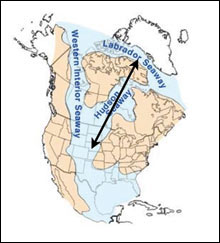
GREAT INLAND SEA A diagram by spurse. |
Having found their way to the threshold of the great Kansas plains, the conquistadors quickly lost it again; so vast was this grassland expanse that the explorers needed their sea compasses to make heads and tails of it.
Forty-five million years ago the Great Inland Sea covered most of North America, spreading from Mexico to Greenland. As the Arctic ice melts, the Great Inland Sea prepares to reclaim lost territory. By 2050, summers in the Arctic Ocean may be ice-free.
This spring, spurse — an international collective of artists, architects, designers, writers, and philosophers — enter research mode for a project aimed at developing strategies for living and thinking in preparation for a coming era of global refugees that could include all of us as we’re displaced by resurgent seas.
The Phoenix caught up with two members of spurse, artists Paul Bartow and Iain Kerr — a Portland resident and Maine College of Art professor — to find out more about the project, now under way in preparation for a pair of exhibitions in fall 2008 at Grand Arts and the Linda Hall Library, both in Kansas City.
Spurse
Our two test sites will be Kansas City and Baffin Island in the High Arctic. We plan to base ourselves in Iqaluit, the capital of Nunavut, a semi-independent territory of Canada. This is a region that is experiencing a genuine development in self-governance, resurgence of native language, cultural and social self-determination. And at the same time the region is experiencing the radical effects of rapid climate change. Currently the Inter-American Commission on Human Rights is hearing a petition from the Inuit Circumpolar Conference on greenhouse gases undermining the sustainability of their traditional lifestyles.
We plan to develop and test a cohesive refugee system that would address three primary questions. The first is the question of deep-time: one of the reasons for our current global condition of Rapid Climate Change is that we have not developed a sense of the vast temporal scales of our actions or understood the complex causalities that these actions are part of. The second is the question of how to devise viable nomadic housing in the face of these changing conditions. And the third is the question of how to use emerging technologies to record and inscribe a vast array of histories into the world.
What do you mean when you say that your research shall inscribe histories “into the world”?
We’re led to imagine that information resides in libraries and is in some sense separate from the world. Couldn’t we instead find ways to allow information to remain in the world that it “comes from,” deposited in or at the site of the event, issue, or concern it relates to?
One of our collaborators, researcher Sean White from Columbia University, is developing a system that allows data to be collected and deposited in virtual overlay into the very landscape that it comes from, and made visible through projection onto a set of glasses that enable one literally to see it present as one moves through one’s surroundings. Sean has already developed such portable systems for botanical researchers.